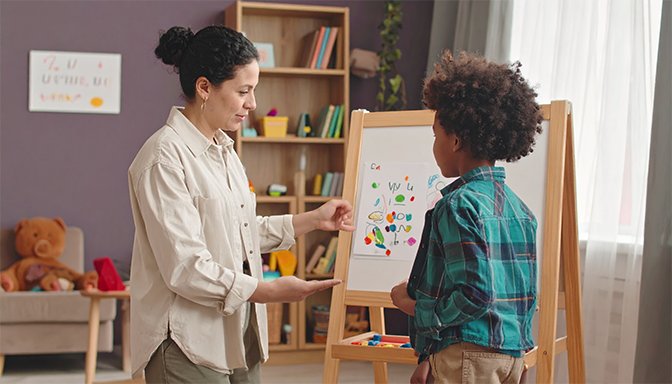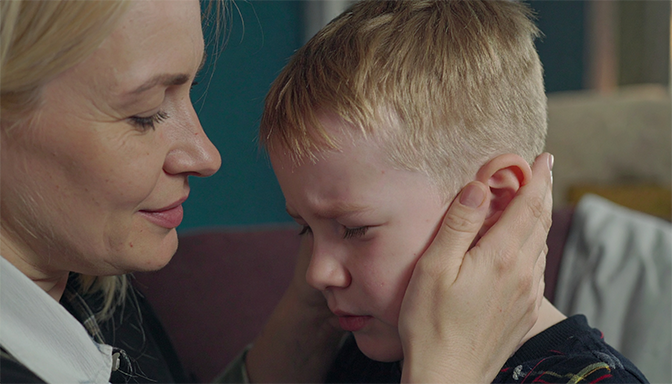5 Smart Ways to Set Boundaries That Actually Work (Without the Power Struggles)
5 Smart Ways for Setting Boundaries with Children That Actually Work
Nothing tests a parent’s sanity quite like a child who seems determined to push every single boundary you’ve ever set. One minute you’re calmly explaining why bedtime is at 8 PM, and the next minute you’re in a full-blown negotiation that somehow escalates into tears, threats, and everyone feeling frustrated. You know boundaries are important for your child’s development and your family’s functioning, but actually enforcing them without constant battles feels impossible some days.
Setting boundaries with children can be a challenging task for any parent, but the rewards are worth the effort.
Here’s what makes boundary-setting so challenging: children are naturally wired to test limits as part of their normal development, but most parents haven’t learned effective strategies for setting and maintaining boundaries without turning every interaction into a power struggle. Traditional approaches often rely on punishment, threats, or authoritarian control that might get compliance in the moment but damage the parent-child relationship and don’t teach children the internal motivation to make good choices.
The good news is that effective boundary-setting, including setting boundaries with children, isn’t about becoming stricter or more controlling – it’s about becoming clearer, more consistent, and more strategic in how you communicate and enforce expectations. When children understand the reasoning behind boundaries and feel respected in the process, they’re much more likely to cooperate and internalize the values you’re trying to teach.
By consistently setting boundaries with children, parents foster a sense of security that is vital for healthy development.
Understanding the Importance of Setting Boundaries with Children
1. Explain the “Why” Behind Your Boundaries in Age-Appropriate Ways

One of the biggest reasons children resist boundaries is that they don’t understand the purpose behind them. When rules feel arbitrary or unfair, children naturally push back because the restrictions don’t make sense from their perspective. Taking time to explain the reasoning behind your expectations helps children understand that boundaries exist for good reasons, not just because you want to control them.
When you start setting boundaries with children, the initial conversations can lay the groundwork for future success.
This doesn’t mean you need to justify every single rule or get into lengthy debates about family expectations. It means providing clear, simple explanations that help children understand how boundaries protect them, help the family function better, or teach important values. When children understand the “why,” they’re more likely to follow rules even when you’re not around to enforce them.
Remember, setting boundaries with children is about nurturing their understanding of respect and responsibility.
Age-appropriate explanations also show respect for your child’s developing reasoning abilities and help them learn to think through the consequences of their choices rather than just following rules blindly.
Effective Boundary Explanations:
- “We have a bedtime because your body needs sleep to grow and learn”
- “We clean up toys so our house is safe and comfortable for everyone”
- “We use respectful words because everyone in our family deserves to be treated kindly”
- “We have screen time limits because too much screen time isn’t healthy for your brain”
- “We wear seatbelts because they keep us safe if there’s an accident”
- “We take turns because it’s fair and helps everyone have fun”
Adjusting Explanations for Different Ages
Young children need simple, concrete explanations focused on safety and fairness. School-age children can understand more complex reasoning about consequences and family values. Teenagers can engage with discussions about personal responsibility and how boundaries prepare them for adult decision-making.
As you navigate setting boundaries with children, it’s essential to adjust your strategies based on their developmental stage.
The key is providing enough explanation to help them understand without getting into power struggles about whether they agree with your reasoning.
2. Set Boundaries Proactively Rather Than Reactively

Many parents find themselves setting boundaries in the heat of the moment when children are already misbehaving or testing limits. This reactive approach often leads to inconsistent rules, harsh consequences delivered in frustration, and children who never know what to expect. Proactive boundary-setting involves establishing clear expectations before problems arise.
When parents start setting boundaries with children early, it helps create a foundation for future interactions.
This means having calm conversations about family rules and expectations during peaceful moments rather than trying to establish boundaries while you’re dealing with challenging behavior. When children know what’s expected of them ahead of time, they’re more likely to succeed and less likely to test limits just to figure out where they are.
Proactive boundary-setting also allows you to involve children in creating family rules and consequences, which increases their buy-in and cooperation. When children help establish expectations, they feel more ownership over following them.
Proactive Boundary-Setting Strategies:
Proactive boundary-setting includes regularly discussing the importance of setting boundaries with children.
- Hold family meetings to discuss and establish household rules together
- Preview expectations before new situations: “When we go to the store, we’ll keep our hands to ourselves and use inside voices”
- Create visual reminders of important rules for younger children
- Practice expected behaviors through role-playing before challenging situations
- Establish routines that build boundary-following into daily life
- Review and adjust family rules periodically as children grow and mature
Making Expectations Clear and Consistent
When boundaries are established proactively, children know what to expect and parents can enforce rules more consistently. This clarity reduces testing behavior because children aren’t trying to figure out where the limits are – they already know.
By clearly communicating why setting boundaries with children is crucial, you foster understanding and cooperation.
Proactive boundary-setting also prevents the emotional reactivity that often happens when parents are trying to establish rules while dealing with misbehavior.
Also, try a large magnetic rewards chart or a digital calendar chore chart to keep expectations and rewards in sight and always accessible.
3. Use Natural Consequences Instead of Arbitrary Punishments

Traditional punishment often creates power struggles because children focus on the unfairness of the consequence rather than learning from their choices. Natural consequences, on the other hand, are directly related to the behavior and help children understand the real-world results of their decisions without parents having to be the “bad guy.”
Natural consequences work because they make sense to children and teach genuine life lessons rather than just compliance through fear. When children experience the logical results of their choices, they learn to make better decisions based on understanding rather than just avoiding punishment.
This approach also preserves the parent-child relationship because you’re not constantly having to punish and control – you’re simply allowing reality to teach important lessons while providing support and guidance.
Implementing natural consequences when setting boundaries with children allows them to learn organically.
Natural Consequence Examples:
- If they don’t put their bike away, it might get damaged by weather (natural consequence) vs. losing TV time (arbitrary punishment)
- If they don’t pack their lunch, they eat what’s available at school vs. getting yelled at about responsibility
- If they spend their allowance impulsively, they don’t have money for something they want later vs. extra chores as punishment
- If they don’t wear a coat, they feel cold vs. losing privileges unrelated to the choice
- If they don’t complete homework, they deal with teacher consequences vs. parent-imposed restrictions
- If they’re rude to friends, friends don’t want to play vs. timeout imposed by parents
Implementing Natural Consequences Supportively
The goal isn’t to let children suffer or learn through harsh experiences, but to allow them to experience the logical results of their choices while providing emotional support and guidance. You can empathize with their disappointment while still allowing them to learn from natural consequences.
Sometimes you’ll need to create logical consequences when natural ones aren’t sufficient or safe, but they should still be directly related to the behavior and focused on learning rather than punishment.
4. Stay Calm and Consistent During Boundary Testing

Children test boundaries not because they’re bad kids, but because testing is how they learn about expectations, safety, and relationships. When parents understand that boundary testing is normal and developmental, they can respond more calmly and consistently rather than taking testing behavior personally or getting into emotional power struggles.
During moments of boundary testing, explaining the reasoning behind setting boundaries with children can mitigate conflicts.
Staying calm during boundary testing is crucial because children are watching how you handle pressure and conflict. When you maintain your composure while consistently enforcing boundaries, you’re teaching them that rules are stable and reliable, not dependent on your mood or their emotional reactions.
Consistency is equally important because children need to know that boundaries are real and dependable. When enforcement varies based on your energy level, mood, or circumstances, children learn to test more frequently to see if this is one of the times when boundaries don’t apply.
Calm Boundary Enforcement Techniques:
- Take deep breaths before responding to testing behavior
- Use a neutral tone when redirecting or enforcing consequences
- Stick to previously established consequences rather than making up new ones in the moment
- Avoid getting drawn into arguments about whether the boundary is fair
- Follow through consistently even when it’s inconvenient for you
- Remember that testing is normal and temporary, not a reflection of your parenting
Maintaining Authority Without Becoming Authoritarian
Calm, consistent boundary enforcement maintains your parental authority while still respecting your child’s emotions and developmental needs. You can be firm about expectations while remaining kind and understanding about their frustration with limits.
It’s important to balance kindness and authority when setting boundaries with children to maintain trust.
The goal is helping children feel secure in your leadership while learning to manage their own emotions around disappointment and limits.
If you’ve ever found yourself raising your voice more than you’d like, you’re not alone. Staying calm when kids push limits is a skill you can practice. The course Raising Resilient Responsible Independent Children walks you through practical, easy-to-use techniques that help you set firm boundaries while keeping your cool, even on the tough days.
5. Involve Children in Problem-Solving When Boundaries Aren’t Working

Sometimes despite your best efforts, certain boundaries continue to be problematic areas that create ongoing conflicts or aren’t working effectively for your family. Instead of just getting stricter or giving up, involve your children in collaborative problem-solving to find solutions that work better for everyone.
Involving kids in discussions around setting boundaries with children encourages accountability.
This approach teaches children valuable problem-solving skills while also increasing their cooperation because they have input into creating solutions. When children help solve boundary problems, they’re more invested in making the solutions work and less likely to continue testing in those areas.
Collaborative problem-solving also shows children that boundaries can be adjusted when there are good reasons, while still maintaining important safety and respect expectations. This flexibility prevents boundaries from becoming rigid control battles while still maintaining necessary structure.
Collaborative Problem-Solving Steps:
- Acknowledge that the current approach isn’t working well for anyone
- Ask for their input: “What’s making this rule hard to follow?” or “What would help you remember this expectation?”
- Brainstorm solutions together that address both their needs and your important concerns
- Try new approaches for a specific time period and evaluate how they’re working
- Adjust solutions based on what you learn, involving children in the evaluation process
- Maintain non-negotiable safety and respect expectations while being flexible about methods
Teaching Life Skills Through Boundary Discussions
When children participate in solving boundary problems, they’re learning crucial life skills like identifying problems, brainstorming solutions, evaluating results, and adjusting approaches based on new information. These skills serve them throughout their lives in relationships, work, and personal challenges.
This collaborative approach also strengthens your relationship because children feel heard and respected while still learning important limits and expectations.
When children help shape the rules around setting boundaries with children, they feel more invested in the outcomes.
Conclusion: Building Cooperation Through Effective Boundaries
Effective boundary-setting isn’t about controlling your children’s every move or getting perfect compliance – it’s about creating clear expectations that help children feel secure while learning important life skills and values. When boundaries are set thoughtfully and enforced consistently with respect for children’s developmental needs, they actually increase cooperation and strengthen family relationships.
By consistently reinforcing the importance of setting boundaries with children, parents can effectively guide behavior.
Remember that learning to follow boundaries is a process that takes time and practice. Children will test limits, make mistakes, and need reminders as they develop self-control and internal motivation. Your patience and consistency during this learning process teaches them that expectations are stable and that you believe in their ability to grow and improve.
The children who develop the strongest internal motivation and self-discipline are often those whose parents learned to set boundaries with clarity, consistency, and respect rather than through control, punishment, or power struggles. The investment you make in effective boundary-setting now pays dividends throughout your child’s development and your lifelong relationship.
Ultimately, setting boundaries with children lays the groundwork for their future independence and decision-making skills.
Your Effective Boundary-Setting Action Plan
-
- Explain the reasoning behind important boundaries in ways your child can understand
Establishing routines that incorporate setting boundaries with children ensures they understand expectations clearly.
-
- Establish expectations proactively during calm moments rather than reacting to misbehavior
- Use natural consequences that teach real-world lessons rather than arbitrary punishments
- Stay calm and consistent when children test boundaries, remembering that testing is normal development
- Involve children in collaborative problem-solving when boundaries aren’t working effectively
Daily interactions around setting boundaries with children can strengthen family bonds and improve communication.
Remember: The goal of boundaries isn’t perfect compliance – it’s helping children develop the internal motivation and skills they need to make good choices throughout their lives while maintaining strong family relationships.
Affiliate Disclaimer: As an affiliate of other sites and as an Amazon Associate we earn from qualifying purchases. Some links in this article may be affiliate links where a purchase would provide us with a commission. We only recommend products and services we truly believe can help you on your personal growth journey.
Advice Disclaimer: This advice is for informational and entertainment purposes only and not a substitute for professional counseling, therapy, financial, legal, or medical advice. You are responsible for your own decisions and actions. For serious issues, please consult qualified professionals.
6 Proven Strategies to Handle Teen Attitude Without Losing Your Cool
6 Proven Strategies to Handle Teen Attitude Without Losing Your Cool
That moment when your previously sweet child transforms into a master of eye-rolling, dramatic sighing, and responses that could freeze water, you realize you’ve officially entered the teenage years. One minute they’re asking for help with homework, and the next they’re treating you like you’re the most embarrassing, clueless person on the planet. The attitude seems to come out of nowhere, and suddenly every conversation feels like you’re walking through a minefield of sarcasm and defensiveness.
Here’s what makes teenage attitude so challenging for parents: it often feels personal and disrespectful, even though it’s usually more about their developmental stage than their actual feelings about you. Teenagers are literally rewiring their brains while dealing with hormonal changes, social pressures, and the overwhelming task of figuring out who they are separate from their families. The attitude is often their clumsy way of asserting independence while still needing your guidance and support.
The key to handling teenage attitude effectively isn’t to eliminate it completely (which is impossible anyway), but to respond in ways that maintain your relationship while still setting appropriate boundaries. When parents learn to stay calm during attitude storms and respond strategically rather than reactively, they often find that the teenage years become opportunities for deeper connection rather than constant power struggles.
1. Don’t Take Their Attitude Personally (Even When It Feels Like an Attack)

The hardest part about dealing with teenage attitude is that it often feels like a direct attack on you as a person and a parent. When your teen rolls their eyes at your suggestions, snaps at you for asking simple questions, or acts like spending time with you is torture, it’s natural to feel hurt, frustrated, or angry. But understanding that teenage attitude is rarely about you personally can help you respond more effectively.
Teenagers are developmentally programmed to push away from their parents as they figure out their own identity and independence. The attitude often comes from their own internal struggles with control, identity, and overwhelming emotions rather than genuine disrespect for you. When you can separate their developmental behavior from personal attacks, you’re more likely to stay calm and respond in ways that actually improve the situation.
This doesn’t mean accepting genuinely disrespectful behavior or letting them treat you poorly. It means understanding the difference between normal teenage testing and behavior that crosses important boundaries, so you can respond appropriately to each situation.
Perspective-Shifting Strategies:
- Remember that attitude often peaks when teens feel most insecure or overwhelmed
- Recognize that pushing away from parents is a normal part of developing independence
- Consider what might be happening in their social or academic life that’s creating stress
- Focus on their underlying needs rather than just the surface attitude
- Remind yourself that this phase is temporary and doesn’t reflect your parenting quality
- Look for moments when their genuine personality shines through the attitude
Maintaining Emotional Distance from Their Mood
When you don’t take teenage attitude personally, you can stay calmer and make better parenting decisions. This emotional distance allows you to see what they might actually need (support, space, boundaries, or just someone to listen) rather than just reacting to their tone or behavior.
Practice viewing their attitude as information about their internal state rather than a judgment about you or your relationship.
2. Stay Calm and Lower Your Voice When They Raise Theirs

One of the most effective ways to de-escalate teenage attitude is to do the opposite of what feels natural when someone is being disrespectful toward you. Instead of matching their energy, raising your voice, or getting defensive, deliberately lower your voice and stay as calm as possible. This approach often catches teens off guard and prevents situations from escalating into full-blown arguments.
When you stay calm during their emotional storms, you’re modeling the kind of emotional regulation you want them to develop. You’re also maintaining your authority as the parent without getting pulled into power struggles that rarely end well for anyone. Teens often escalate their attitude when they sense they can get a big reaction from you, so staying calm removes that reward.
This doesn’t mean being emotionless or accepting inappropriate behavior. It means responding thoughtfully rather than reactively, which gives you more options for addressing both their attitude and any underlying issues that might be driving it.
Calm Response Techniques:
- Take a deep breath before responding to attitude or disrespect
- Lower your voice deliberately when they raise theirs
- Use a neutral tone even when setting firm boundaries
- Pause before reacting to give yourself time to choose your response
- Focus on one issue at a time rather than bringing up everything that’s bothering you
- Use body language that stays relaxed and non-threatening
De-escalation Through Emotional Regulation
When you stay calm, you’re not only preventing the immediate situation from getting worse, you’re also teaching your teenager important skills about managing difficult emotions and conflicts. They’re watching how you handle stress and disagreement, which becomes part of their learning about adult emotional regulation.
Your calm response also makes it more likely that they’ll actually hear what you’re saying rather than just reacting to your emotional energy.
3. Set Clear Boundaries While Still Respecting Their Growing Need for Independence

The teenage years require a delicate balance between maintaining important family rules and expectations while gradually giving teens more autonomy and decision-making power. Effective boundary-setting with teenagers involves being clear about non-negotiable expectations while being flexible about areas where they can have more control and input.
This means distinguishing between rules that are about safety, respect, and family functioning (which should be maintained firmly) and preferences that can be negotiated or areas where teens can make their own choices and learn from the consequences. When teenagers feel like they have some control and input in their lives, they’re often less likely to fight every boundary.
Clear boundaries also help teenagers feel secure even when they’re pushing against them. Consistent, reasonable expectations provide structure during a time when everything else in their lives feels chaotic and changing.
Effective Boundary Setting for Teens:
- Explain the reasoning behind important rules rather than just saying “because I said so”
- Involve them in creating family rules and consequences when possible
- Be consistent with enforcement while allowing for discussion and negotiation
- Focus on safety, respect, and family functioning as non-negotiable areas
- Allow natural consequences to teach lessons when the stakes aren’t too high
- Adjust expectations gradually as they demonstrate responsibility and maturity
In fact, Raising Resilient Responsible Independent Children programs are an affordable way to get the extra support you need to make sure you do this in an effective way.
Balancing Structure with Autonomy
The goal is creating enough structure to keep them safe and teach important values while giving them enough freedom to develop their own decision-making skills and sense of independence. This balance looks different for every teenager and family, depending on maturity level, past behavior, and specific circumstances.
When teens feel respected and heard in the boundary-setting process, they’re more likely to cooperate even when they don’t love the rules.
4. Choose Your Battles Wisely and Focus on What Actually Matters

Not every instance of teenage attitude requires a parental response or intervention. Learning to distinguish between behavior that needs addressing and attitude that’s better ignored can save your relationship and your sanity during the teenage years. Some attitude is just part of the developmental process and will resolve itself as they mature.
Focus your energy on addressing behavior that affects safety, respect for family members, or important family values, while letting go of attitude about smaller issues like clothing choices, room organization, or musical preferences. When you’re not constantly correcting every eye roll or sarcastic comment, your interventions carry more weight and are more likely to be effective.
This strategic approach also prevents the constant conflict that can damage your relationship during these crucial years. When teens feel like they’re always in trouble or being corrected, they often become more defiant and less likely to come to you when they really need guidance.
Battle-Choosing Guidelines:
- Address attitude that involves disrespect toward family members or important values
- Let go of attitude about personal preferences that don’t affect others
- Focus on behavior rather than just tone or facial expressions
- Save energy for issues that actually matter for their development and safety
- Ignore minor attitude that’s clearly about testing boundaries rather than genuine disrespect
- Pick one or two main issues to work on rather than trying to correct everything
Preserving Relationship Capital
Every negative interaction with your teenager uses up some of your “relationship capital” – the goodwill and connection that makes them want to listen to you and maintain a positive relationship. When you choose battles wisely, you preserve this capital for the conversations and issues that really matter.
Focus on building positive interactions and connections alongside addressing only the most important behavioral issues.
5. Look for the Underlying Need Behind the Attitude

Teenage attitude often masks deeper feelings like insecurity, overwhelm, sadness, or fear. Instead of just addressing the surface behavior, try to understand what your teenager might actually need in that moment. Sometimes attitude is their way of asking for help, attention, space, or support without knowing how to ask directly.
This detective work requires looking beyond their words and tone to consider what might be happening in their world. Are they stressed about school, struggling with friendships, feeling insecure about their appearance, or overwhelmed by decisions about their future? When you can identify and address the underlying need, the attitude often improves naturally.
This approach also communicates to your teenager that you see them as a complete person with complex feelings rather than just someone whose behavior needs to be controlled. This understanding often leads to better communication and cooperation over time.
Need-Detective Strategies:
- Ask gentle questions about what’s really going on in their life
- Notice patterns in when attitude tends to be worst
- Look for signs of stress, sadness, or overwhelm beneath the surface attitude
- Offer specific types of support: “Do you need help, space, or just someone to listen?”
- Address underlying issues rather than just correcting surface behavior
- Validate difficult feelings while still maintaining appropriate boundaries
When you find mental health areas beyond your ability to solve on your own reach out to a therapist trained in teen matters who can meet with you and/or your teen virtually from the convenience of your own home. Try Online-Therapy.com .
Meeting Needs Proactively
When you can identify what your teenager typically needs during difficult moments, you can often prevent attitude problems by meeting those needs proactively. If they usually need space when they’re overwhelmed, you can offer it before they have to push you away rudely.
This approach helps build trust and communication while reducing the frequency of attitude problems.
6. Maintain Connection Even During Difficult Phases

Perhaps the most important strategy for handling teenage attitude is maintaining emotional connection with your teenager even when they’re being difficult. This means continuing to show interest in their lives, expressing love and appreciation, and looking for positive moments together despite the challenging behavior.
Teenagers need to know that your love and support aren’t conditional on their behavior or attitude. When they feel secure in your relationship, they’re more likely to come to you when they’re struggling and less likely to use attitude as a way to test your commitment to them.
This doesn’t mean ignoring problems or accepting disrespectful behavior, but it does mean separating your response to specific behaviors from your overall relationship and love for them as a person.
Connection Maintenance Strategies:
- Continue expressing love and appreciation regularly, even during difficult periods
- Look for opportunities to spend positive time together when they’re receptive
- Show interest in their activities, friends, and interests without being intrusive
- Share appropriate parts of your own life and experiences with them
- Apologize when you handle situations poorly or lose your temper
- Remember and mention positive qualities and past good times together
Building Long-term Relationship Security
The relationship you maintain during the teenage years often determines the quality of your adult relationship with your child. When teenagers feel loved and supported despite their temporary attitude problems, they’re more likely to maintain close family relationships as adults.
Focus on the long-term relationship rather than just managing immediate behavior problems, and remember that this difficult phase is temporary while your relationship is permanent.
Conclusion: Surviving and Thriving Through the Teenage Years
Handling teenage attitude effectively isn’t about eliminating all challenging behavior or turning your teenager into a perfectly compliant young adult. It’s about maintaining your relationship, teaching important values, and supporting their development into independent, responsible adults while preserving your own sanity and family harmony.
Remember that the teenage years are temporary, but the relationship skills you develop during this time will serve your family for decades to come. When you respond to teenage attitude with patience, understanding, and strategic thinking rather than just reacting emotionally, you’re modeling the kind of emotional intelligence and conflict resolution skills you want your teenager to develop.
The teenagers who have the easiest transition to adulthood are often those whose parents learned to balance understanding and boundaries, connection and independence, during these challenging years. Your patience and strategic responses during attitude storms are investments in your long-term relationship and their emotional development.
Your Teen Attitude Survival Plan
- Remember that attitude is usually about their development, not personal attacks on you
- Stay calm and lower your voice when they escalate, modeling emotional regulation
- Set clear boundaries about respect while allowing growing independence in appropriate areas
- Choose battles wisely, focusing energy on issues that truly matter for safety and values
- Look for underlying needs like stress, insecurity, or overwhelm behind surface attitude
- Maintain connection and express love consistently, even during difficult behavioral phases
Remember: The goal isn’t to have a perfectly behaved teenager – it’s to maintain a strong relationship while helping them develop the emotional regulation and independence skills they’ll need as adults.
Affiliate Disclaimer: As an affiliate of other sites and as an Amazon Associate we earn from qualifying purchases. Some links in this article may be affiliate links where a purchase would provide us with a commission. We only recommend products and services we truly believe can help you on your personal growth journey.
Advice Disclaimer: This advice is for informational and entertainment purposes only and not a substitute for professional counseling, therapy, financial, legal, or medical advice. You are responsible for your own decisions and actions. For serious issues, please consult qualified professionals.
7 Ways to Build Strong Emotional Connections with Your Kids (At Any Age)
7 Ways to Build Strong Emotional Connections with Your Kids (At Any Age)
That moment when your child opens up to you about something important – a friendship drama, a fear they’ve been carrying, or a dream they’re afraid to share – feels like pure magic. You’re reminded that beneath all the daily logistics of parenting (the nagging about homework, negotiating screen time, and managing bedtime routines), there’s this incredible little person who trusts you enough to share their inner world. These moments of genuine connection are what make all the challenging parts of parenting worthwhile.
But here’s what’s frustrating: those beautiful connection moments can’t be forced or scheduled. You can’t demand that your 8-year-old share their deepest feelings over dinner, or expect your teenager to suddenly want heart-to-heart conversations just because you’re finally available to listen. Building emotional connections with children requires patience, consistency, and understanding that connection happens on their terms, not yours.
The good news is that emotional connection with children isn’t about having perfect parenting moments or deep conversations every day. It’s about creating an overall relationship environment where your kids feel safe, understood, and valued for who they are rather than just what they do. When children feel emotionally connected to their parents, they’re more likely to share problems when they arise, listen to guidance when they need it, and maintain close relationships into adulthood.
1. Listen to Understand Rather Than to Fix or Teach

The biggest barrier to emotional connection with children is the parental instinct to immediately solve problems, give advice, or turn every conversation into a teaching moment. When your child shares that someone was mean to them at school, your first impulse might be to offer solutions, ask probing questions to understand what really happened, or explain how they could handle the situation differently next time.
But what children often need most is simply to be heard and understood before they’re ready for solutions or lessons. When you listen with the goal of truly understanding their experience and feelings, you’re communicating that their emotions matter and that you’re a safe person to share with. This creates the foundation for deeper conversations and trust over time.
Listening to understand means reflecting back what you hear, asking gentle questions to learn more about their experience, and validating their feelings even when you don’t agree with their perspective or behavior. It means resisting the urge to immediately jump into problem-solving mode and instead creating space for your child to feel heard and supported.
Active Listening Strategies for Parents:
- Reflect back what you hear: “It sounds like you felt really left out when that happened”
- Ask open-ended questions: “Tell me more about what that was like for you”
- Validate emotions even when you disagree with behavior: “You were really angry, and that makes sense”
- Wait before offering solutions: “Do you want advice about this, or do you just need me to listen?”
- Put away distractions and give full attention when they’re sharing something important
- Use their language rather than immediately correcting or reframing their perspective
Creating Safe Emotional Space
When children feel heard and understood, they’re more likely to continue sharing their thoughts and feelings. If they sense that opening up always leads to lectures, solutions they didn’t ask for, or having their feelings dismissed, they’ll stop coming to you with the important stuff.
Focus on understanding their emotional experience first, then address any necessary problem-solving or guidance in separate conversations when they’re more receptive.
2. Follow Their Interests and Enter Their World

One of the most powerful ways to connect with children is to show genuine interest in the things that matter to them, even when those things seem silly, boring, or completely foreign to you. Whether your child is obsessed with dinosaurs, video games, sports, art, or collecting random objects, entering their world with curiosity and enthusiasm communicates that you value what they value.
This doesn’t mean you have to become an expert in every single thing your child enjoys, but it does mean paying attention to what lights them up and asking questions that show you care about their interests. When you spend time learning about their favorite subjects or participating in activities they love, you’re creating shared experiences and demonstrating that their passions matter to you.
Following their interests also provides natural opportunities for connection and conversation. It’s often easier for children to open up when they’re talking about something they love, and these conversations can naturally lead to deeper topics about their feelings, friendships, and experiences.
Interest-Based Connection Ideas:
- Ask genuine questions about their favorite books, games, shows, or hobbies
- Participate in activities they enjoy, even if they’re not your natural preference
- Learn basic information about their interests so you can have informed conversations
- Attend their games, performances, or events that matter to them
- Share their excitement when they want to show you something they’ve created or accomplished
- Remember details they’ve shared about their interests and follow up on them later
You can also invest in things like a Craft Kit or a Science Kit to help generate more interests and create more of these experiences.
Balancing Enthusiasm with Authenticity
The key is showing genuine interest rather than fake enthusiasm that children can easily detect. You don’t have to love everything your child loves, but you can appreciate their passion and learn enough to engage meaningfully with their interests.
When you authentically enter their world, children feel valued and understood, which creates natural opportunities for deeper emotional connection.
3. Create Regular One-on-One Time Without Distractions

In busy families, children often compete for parental attention and rarely get focused, uninterrupted time with their parents. Regular one-on-one time – even just 15-20 minutes of focused attention without siblings, phones, or other distractions – can significantly strengthen emotional connections and give children the individual attention they crave.
This dedicated time doesn’t need to involve special activities or cost money. It could be as simple as lying on their bed and talking before sleep, taking a walk around the neighborhood together, or spending time while they play and you give them your complete attention. The key is that it’s predictable, protected, and focused entirely on them.
During one-on-one time, let your child lead the conversation or activity. This isn’t time for addressing behavior issues, giving reminders about responsibilities, or asking about homework. It’s time for them to have your full, positive attention while doing something they enjoy or simply being together without agenda.
One-on-One Connection Strategies:
- Schedule regular individual time with each child, even if it’s brief
- Put away phones and other distractions during focused time together
- Let them choose the activity or conversation topic
- Avoid using this time for corrections, reminders, or difficult conversations
- Be fully present and engaged rather than multitasking
- Make this time consistent and reliable so children can count on it
Quality Over Quantity in Individual Attention
Fifteen minutes of completely focused, positive attention often creates more connection than hours of distracted time together. Children can tell when you’re truly present with them versus when you’re physically there but mentally elsewhere.
Consistency matters more than duration – regular brief connections are more valuable than occasional long periods of attention.
4. Share Your Own Stories and Emotions Appropriately

Children connect more deeply with parents who are willing to be vulnerable and share their own experiences and emotions in age-appropriate ways. This doesn’t mean burdening children with adult problems or using them as emotional support, but it does mean letting them see you as a complete person with feelings, struggles, and experiences rather than just an authority figure.
Sharing your own childhood stories, admitting when you make mistakes, and expressing your emotions in healthy ways teaches children that all feelings are normal and that you understand what it’s like to face challenges. When children see that you’ve experienced similar struggles or emotions, they feel less alone and more willing to share their own experiences.
This vulnerability also models emotional intelligence and healthy expression of feelings, which helps children develop their own emotional awareness and communication skills.
Appropriate Emotional Sharing:
- Share relevant childhood stories when they’re facing similar challenges
- Admit when you make mistakes and model how to apologize or make things right
- Express your emotions in healthy ways: “I’m feeling frustrated right now, so I need a few minutes to calm down”
- Talk about how you handle difficult emotions or stressful situations
- Share what you’re proud of, excited about, or grateful for in age-appropriate ways
- Acknowledge when you don’t know something or when you’re learning too
Maintaining Appropriate Boundaries
The goal is showing your humanity while still maintaining your role as the parent and protector. Share experiences and emotions that help your child understand that everyone faces challenges, but avoid sharing adult problems that would create anxiety or burden them with concerns they can’t handle.
Use your own emotional expression as teaching moments about healthy ways to process and communicate feelings.
5. Validate Their Feelings Even When You Disagree with Their Behavior

One of the most important skills for building emotional connection with children is learning to separate their feelings from their behavior. You can validate and understand your child’s emotions while still setting limits on inappropriate behavior. This approach helps children feel heard and supported while still learning important boundaries and expectations.
When children feel understood, they’re more likely to be cooperative and less likely to escalate emotional situations. Validation doesn’t mean agreeing with everything they do or feel, but it does mean acknowledging that their emotions make sense from their perspective and that all feelings are acceptable, even when all behaviors aren’t.
This skill is particularly important during difficult moments when children are upset, angry, or disappointed. Instead of dismissing their feelings or immediately focusing on behavior correction, start by acknowledging their emotional experience, then address any necessary behavior changes.
Emotion Validation Techniques:
- Acknowledge feelings before addressing behavior: “You’re really angry about this rule, and I understand that”
- Help them name emotions: “It looks like you’re feeling disappointed that we can’t go to the park today”
- Normalize difficult emotions: “It’s really hard when friends say mean things”
- Separate feelings from actions: “It’s okay to feel mad, but it’s not okay to hit your sister”
- Show empathy for their experience: “That sounds really frustrating”
- Avoid minimizing their emotions: “I know this feels really big to you right now”
Teaching Emotional Intelligence Through Validation
When you consistently validate your child’s emotions while maintaining appropriate boundaries around behavior, you’re teaching them that feelings are normal and manageable while actions have consequences. This helps them develop emotional intelligence and self-regulation skills.
Children who feel understood are more likely to listen to guidance and less likely to escalate emotional situations into power struggles.
6. Be Curious About Their Perspective Rather Than Assuming You Know What They’re Thinking

Children’s inner worlds are often much more complex than adults realize, and they frequently have thoughts, feelings, and motivations that differ from what parents assume. Building strong emotional connections requires approaching children with genuine curiosity about their perspective rather than making assumptions about what they’re thinking or feeling based on their behavior.
This means asking open-ended questions that invite them to share their thoughts and feelings rather than leading questions that guide them toward the answers you expect. It means being willing to be surprised by their responses and learning about who they are as individuals rather than just seeing them through the lens of your parental concerns.
Curiosity also involves asking about their experiences, opinions, and ideas on topics beyond just school and behavior. Children have thoughts about friendships, fairness, their future, their family, and the world around them that can provide insight into their personality and values.
Curiosity-Based Connection Questions:
- “What do you think about that?” instead of “Don’t you think you should…”
- “Help me understand why that’s important to you”
- “What was going through your mind when that happened?”
- “How did that make you feel?”
- “What would you do if you were in charge of this situation?”
- “What’s something I don’t know about you that you’d like me to know?”
Discovering Who They Really Are
When you approach children with genuine curiosity, you often discover aspects of their personality, intelligence, and character that surprise you. This deeper understanding strengthens your relationship and helps you parent more effectively because you’re responding to who they actually are rather than who you assume they are.
Curiosity also communicates respect for their individuality and encourages them to think critically about their own experiences and opinions.
7. Create Traditions and Rituals That Are Meaningful to Your Relationship

Shared traditions and rituals create ongoing opportunities for connection and give children positive experiences to anticipate and remember. These don’t need to be elaborate or expensive – simple, consistent traditions often become the most treasured memories and provide regular touchpoints for emotional connection.
Traditions can be seasonal (special holiday activities), weekly (pizza and movie nights), daily (bedtime stories or morning hugs), or milestone-based (special birthday traditions or celebration rituals). The key is that they’re meaningful to your specific relationship and provide opportunities for focused time together and positive shared experiences.
These rituals also create a sense of family identity and belonging that strengthens children’s emotional security and connection to you. When children know what to expect and have special experiences to look forward to, it creates stability and demonstrates that your relationship is a priority.
Meaningful Tradition Ideas:
- Special one-on-one breakfast dates on weekends or school holidays
- Bedtime rituals that include talking about the day’s highlights and challenges
- Annual traditions for birthdays, holidays, or the start of new school years
- Weekly family activities that everyone enjoys and participates in
- Special ways of celebrating achievements or milestones
- Unique family sayings, jokes, or activities that are just yours
Building Lasting Connection Through Consistency
The power of traditions lies in their consistency and the positive anticipation they create. Children remember the feeling of being prioritized and celebrated through these special times, and these memories often become the foundation of their adult relationship with you.
Focus on creating traditions that feel sustainable and enjoyable for your family rather than trying to replicate what other families do or what you think you should be doing.
Conclusion: Building Relationships That Last Beyond Childhood
Strong emotional connections with children aren’t built through perfect parenting moments or constant deep conversations. They’re built through consistent patterns of listening, understanding, showing interest, and demonstrating that your children are valued for who they are as individuals. When children feel emotionally connected to their parents, they develop better emotional intelligence, stronger self-esteem, and more resilient relationships throughout their lives.
Remember that building emotional connection is an ongoing process that looks different at every stage of your child’s development. The specific strategies that work will change as your children grow, but the underlying principles of listening, validating, showing interest, and spending focused time together remain constant.
The investment you make in emotional connection during childhood pays dividends throughout your lifelong relationship with your children. Adults who felt emotionally connected to their parents during childhood are more likely to maintain close relationships with them, seek their guidance during difficult times, and create strong family connections with their own children.
Of course, looking into parenting courses can be valuable in implementing any plan to get closer to your child and develop trust, boundaries, and emotional intelligence. Check out Raising Resilient Responsible Independent Children from Parenting Simply.
Your Emotional Connection Action Plan
- Listen to understand your child’s perspective before offering solutions or teaching moments
- Show genuine interest in their passions and activities, even when they differ from your own
- Create regular one-on-one time that’s focused entirely on them without distractions
- Share your own experiences and emotions in age-appropriate ways that help them feel less alone
- Validate their feelings consistently while maintaining appropriate boundaries around behavior
- Approach them with curiosity about who they are rather than assumptions about what they should be
- Create meaningful traditions and rituals that strengthen your unique relationship
Remember: Emotional connection with children is built through thousands of small interactions that communicate love, acceptance, and genuine interest in who they are. Focus on consistency and authenticity rather than perfection in your parenting approach.
Affiliate Disclaimer: As an affiliate of other sites and as an Amazon Associate we earn from qualifying purchases. Some links in this article may be affiliate links where a purchase would provide us with a commission. We only recommend products and services we truly believe can help you on your personal growth journey.
Advice Disclaimer: This advice is for informational and entertainment purposes only and not a substitute for professional counseling, therapy, financial, legal, or medical advice. You are responsible for your own decisions and actions. For serious issues, please consult qualified professionals.
ParentingPositive Flip2025-08-12T15:11:39-06:00






